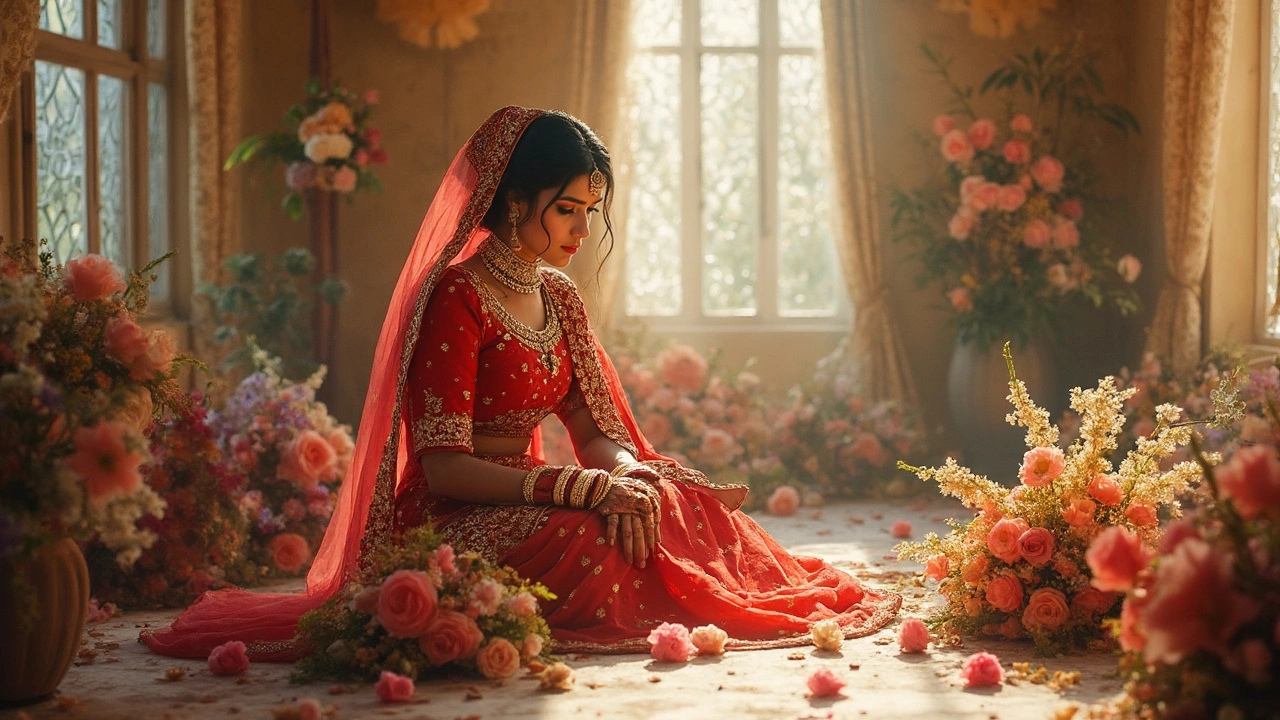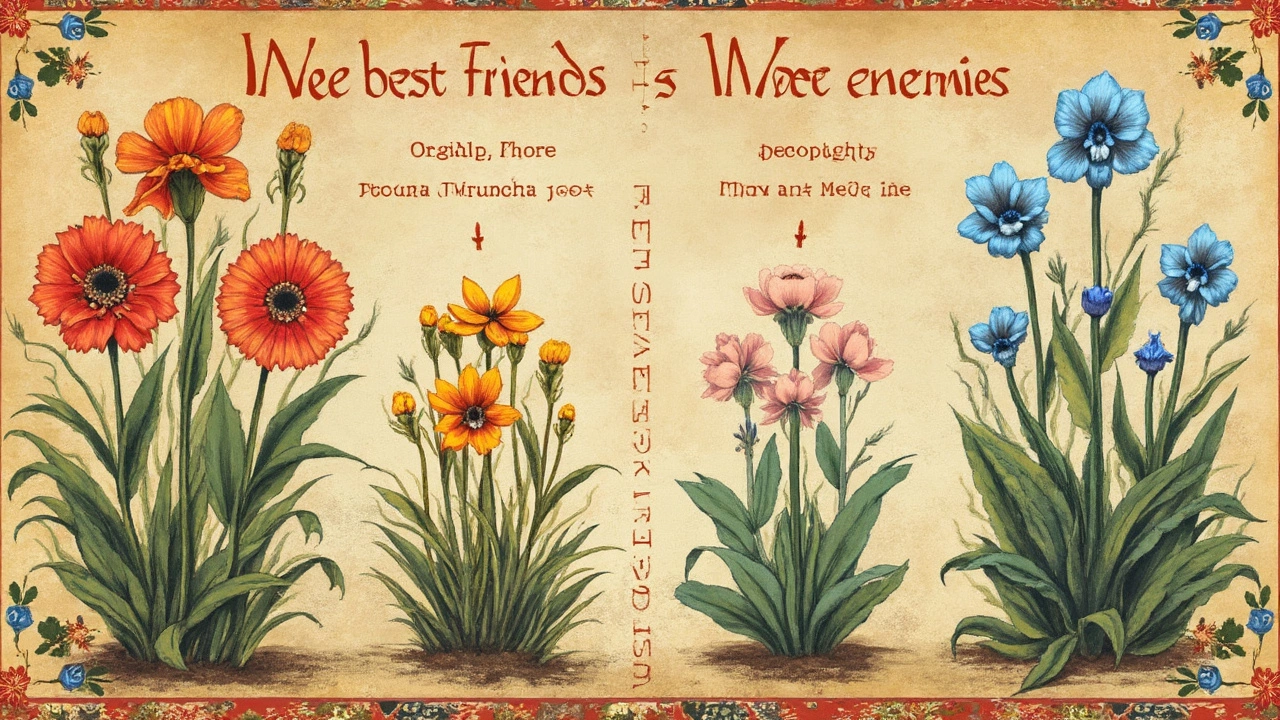
Ever worried your dreamy wedding bouquet could wilt before you even hit the altar? Turns out, not all flowers make good neighbors in an arrangement. Some will fight for water, others will poison their vase-mates—no joke! If you’re planning wedding flowers, knowing what blooms to keep apart saves a lot of stress and sad, droopy petals.
The reason is simple: certain flowers release chemicals, like ethylene gas, that make others age faster. Lilies can make roses blow open too soon, while daffodils ooze a sap that’s toxic for most flowers. It’s not just about looks—some combinations literally cut the life of your arrangement in half.
But don’t panic: with a little knowledge, you can still get the look you want, minus the floral drama. Picking the right combos isn’t just tradition—there’s real science behind it. Keep reading for some common mixing mistakes and easy fixes that’ll keep your bouquet crisp from the aisle to the last dance.
- The Science Behind Flower Compatibility
- Common Flowers That Don’t Mix Well
- Surprising Flower Pairing No-Nos
- Pro Florist Tips for Flawless Wedding Bouquets
- What to Do If You Absolutely Love a Problem Flower
The Science Behind Flower Compatibility
A wedding bouquet isn’t just about pretty colors—flowers have some wild chemistry going on behind the scenes. When you drop different stems into the same vase, they can start an invisible battle for survival. It all boils down to how each flower reacts to things like water, plant sap, and gases in the air.
The biggest issue? Ethylene gas. This sneaky plant hormone speeds up blooming (and sadly, wilting). Some flowers, like carnations and orchids, are really sensitive to ethylene, while others (think lilies or tulips) actually crank it out in larger amounts. Stick an ethylene-producing flower next to a sensitive one, and you’ll watch petals droop faster than you can say “I do.”
Another problem is sap. Daffodils, for example, will leak sticky sap when cut. This goo isn’t just annoying—when it gets in the water, it can actually poison the other stems. That’s why daffodils are best kept in their own vase unless you take special steps to neutralize their sap.
Water needs can mess up your arrangement, too. Some flowers are thirsty and drain the water at lightning speed, leaving their delicate neighbors parched. For instance, hydrangeas are notorious water-hogs, so pairing them with low-hydration flowers means someone’s going to suffer.
If you want to see which popular wedding flowers can clash, check out this snapshot of common culprits:
| Offending Flower | What Happens | Flowers at Risk |
|---|---|---|
| Daffodils | Releases toxic sap | All mixed flowers |
| Lilies | Produces ethylene | Roses, carnations |
| Hydrangeas | Drains water quickly | Peonies, freesia |
One leading florist put it simply:
“The most beautiful bouquet can turn into a droopy disaster if you ignore how flowers interact. Always ask your florist about plant chemistry before mixing.” — Sarah Lim, Bloomwise Floral Studio
So, before you pick any old mix for your bouquet, think about the science side. Spending a few extra minutes learning about flower compatibility can save you a lot of disappointment on the big day (and really, nobody wants wedding photos with limp blooms).
Common Flowers That Don’t Mix Well
Mixing the wrong flowers in a bouquet is like putting cats and dogs in the same carrier—you might regret it fast. Some flowers just do not get along and can ruin your beautiful wedding flowers before the party even starts. Here’s what the experts and studies say you should always keep apart.
wedding flowers like daffodils look fresh and cheery, but once they’re cut they ooze a slimy sap that can damage most other flowers. Mix daffodils in with tulips, roses, or lilies—expect wilt city. You need to quarantine them in their own water for at least 24 hours before adding, or skip them if you’re not willing to babysit blooms.
Another red flag? Lilies and roses. Lilies release a gas called ethylene. Roses are super sensitive to that and will pop open their petals way too soon. The same goes for carnations and orchids; carnations drink up water at a crazy fast rate, leaving less for everyone else.
If you’re thinking about hydrangeas in your centerpiece, be careful. They are water hogs, so they’ll steal from whatever other blooms you stick them with, especially peonies and ranunculus. Hydrangeas have thick, woody stems that suck up water fast, making them tough partners for delicate flowers with thinner stems.
- Daffodils – Toxic sap; harms almost all other blooms
- Roses & Lilies – Ethylene from lilies shortens rose life
- Hydrangeas – Outdrinks sensitive flowers like peonies and ranunculus
- Irises – Notorious for leaking a slimy sap that’s rough on neighboring stems
- Tulips & Narcissus (daffodils) – Tulips fade quickly around daffodils
It’s not just florist superstition. A comparison of vase life from Michigan State’s floriculture studies showed bouquets with lilies and roses together dropped petals 40% faster than bouquets with only roses. Check out the rough stats below based on popular pairings:
| Flower Combo | Average Vase Life (Days) |
|---|---|
| Roses only | 7 |
| Daffodils with others | 3–4 |
| Hydrangeas with peonies | Under 3 |
| Roses & Lilies | 4 |
If you don’t want to take just my word for it, here’s what top florist Emma Farrow says:
"Mixing daffodils or lilies with most other blooms is asking for trouble. The resulting bouquet might look gorgeous at first, but give it a couple of hours in a warm reception and you’ll be left with limp, sad flowers."
Don’t feel stressed, though. There’s always a smart workaround—sometimes it means using water tubes, prepping stems twice, or simply building your bouquet in separate batches. Up next: surprising pairs you might not expect are a recipe for disaster!

Surprising Flower Pairing No-Nos
Mixing wedding flowers isn’t just about color or style. Sometimes it’s the sneaky chemistry that causes real trouble. You probably know that daffodils and tulips are tricky, but there are a few common pairings even pros sometimes forget to avoid.
- Lilies and Roses: Sure, they both scream romance, but lilies pump out so much pollen and ethylene gas that roses next to them usually blow open too fast, looking tired on the big day. If you must have both, try separating them across your arrangements rather than combining them in one bouquet.
- Tulips and Daffodils: Daffodils ooze a milky sap that clogs the stems of tulips and pretty much everything else, cutting their vase life by a third. Even a quick rinse won’t do the trick unless you condition daffodils separately for at least 24 hours before mixing.
- Orchids and Anything Fragrant: Orchids look fancy, but their delicate petals soak up strong scents and can basically shrivel next to fragrant flowers like freesia or stock.
- Sunflowers and Delicate Blooms: Sunflowers drink water like crazy and can leave none for soft-stemmed flowers like sweet peas or ranunculus. The little guys end up droopy and sad while the sunflowers hog the spotlight (and hydration).
- Hydrangeas and Eucalyptus: Hydrangeas are thirsty and wilt easily, especially when mixed with eucalyptus, which can actually sap water away from the hydrangea's stem tip.
Check out this quick table with some real-life pairings to skip, plus the main problem that happens if you mix them together:
| Pairing | Main Issue | Estimated Lifespan Loss |
|---|---|---|
| Lilies + Roses | Roses open too fast | Up to 50% shorter |
| Tulips + Daffodils | Clogged stems, wilt | About 30% shorter |
| Orchids + Strong-scented | Orchids wilt | Lose freshness overnight |
| Sunflowers + Sweet Peas | No water left for sweet peas | Usually wilt in 1 day |
| Hydrangeas + Eucalyptus | Hydrangeas dry up | Wilt within hours |
So when you’re picking out your wedding flowers, don’t just think look and color—think about who is sitting next to who in your bouquet. The wrong roommate situation can turn your dream blooms into a floral flop faster than you think. If you’re unsure, ask your florist. A little planning saves a lot of frustration (and fridge space) in the days before you say “I do.”
Pro Florist Tips for Flawless Wedding Bouquets
Pro florists never just toss flowers in a vase and hope for the best. They’ve seen what works—and, more importantly, what falls apart fast. If you want a wedding bouquet that stays fresh and fabulous from morning until the last selfie, here’s what the pros always keep in mind.
- Wedding flowers drink a lot of water, but some are thirstier than others. Roses, for example, can suck up more water than their neighbors, leaving things like hydrangea droopy by cocktail hour. Solution: Prep each stem separately and use small water tubes for fragile blooms if you’re combining them.
- Never mix daffodils with anything unless you soak their stems alone for at least 24 hours first. Their sap is basically bouquet poison.
- Always cut stems at an angle before arranging and strip leaves that would sit below the water line. This keeps the water cleaner and helps each flower drink up.
- Give arrangements a cool spot to rest out of direct sun and away from fruit. Bananas and apples give off ethylene gas that can age your flowers in record time.
- Don’t just trust your eye—test your bouquet combo a week before the wedding. Make a mini version and see how it lasts overnight.
Check this quick guide on common flowers and their trouble level in mixed bouquets:
| Flower | Mixing Issues | Pro Tip |
|---|---|---|
| Daffodil | Toxic sap for other flowers | Soak stems alone before mixing |
| Lily | Speeds up aging of roses/tulips | Keep lilies and delicate blooms separate |
| Rose | Very thirsty; hogs water | Re-cut stems often and watch water levels |
| Hydrangea | Wilts fast without water | Use tubes for hydration |
If you’re a checklist person, here’s what you always want to do right before the big day:
- Check stems and re-cut them.
- Top up water every few hours, especially in hot weather.
- Store bouquets in a cool place (not the fridge if fruit is inside!) until you need them.
- Avoid last-minute mixes with troublemakers like daffodils or lilies if you’re not sure how they’ll do.
These tricks aren’t just for the pros—anyone can follow them for wow-worthy wedding flowers with zero surprises.

What to Do If You Absolutely Love a Problem Flower
Sometimes, you just can’t let go of that one flower—even if it’s notorious for causing issues in wedding arrangements. Say you’re set on daffodils, but you’ve heard their sap makes other blooms wilt fast. Don’t stress; there are workarounds you can use to safely add these tough characters to your bouquet.
Here’s how you can have your favorite troublemaker without sabotaging the rest of your wedding flowers:
- Condition the Problem Flower: For daffodils and narcissus, let the stems soak alone in water for 12-24 hours after cutting, then rinse them well. Only after this should you add them to the arrangement—this lessens the sap risk.
- Use Flower Tubes: Those little plastic water tubes might look old school, but they keep sap and weird chemicals away from the rest of the stems. Pop them on lilies, daffodils, or hyacinths you just can’t live without.
- Separate in the Design: Arrange sensitive flowers in their own mini-bouquet or cluster. It keeps them from hurting the rest, and you can still show off your favorite bloom.
- Swap in Similar-Looking Flowers: Love the color or shape, but not the hassle? Ask your florist to suggest a lookalike. For example, ranunculus can sometimes give you the same vibe as peonies, minus the early wilting problem.
Check out how common ‘problem’ flowers measure up for wedding arrangements—the more stars, the trickier they are to mix:
| Flower | Common Issue | Mixing Difficulty (1-5 stars) |
|---|---|---|
| Daffodil/Narcissus | Toxic sap | ⭐⭐⭐⭐⭐ |
| Lily | Speeds up aging of other blooms | ⭐⭐⭐ |
| Hyacinth | Releases sap | ⭐⭐⭐ |
| Peony | Short vase life | ⭐⭐ |
| Gardenia | Wilts with touch, sensitive | ⭐⭐⭐⭐ |
Loving a tricky flower doesn’t mean you have to give it up. Just work with your florist, tell them your must-haves, and let them handle the science-y part of keeping everything fresh. That way, your wedding flowers look just like you pictured—no disappointments and definitely no wilted surprises.



Comments
Post Comment